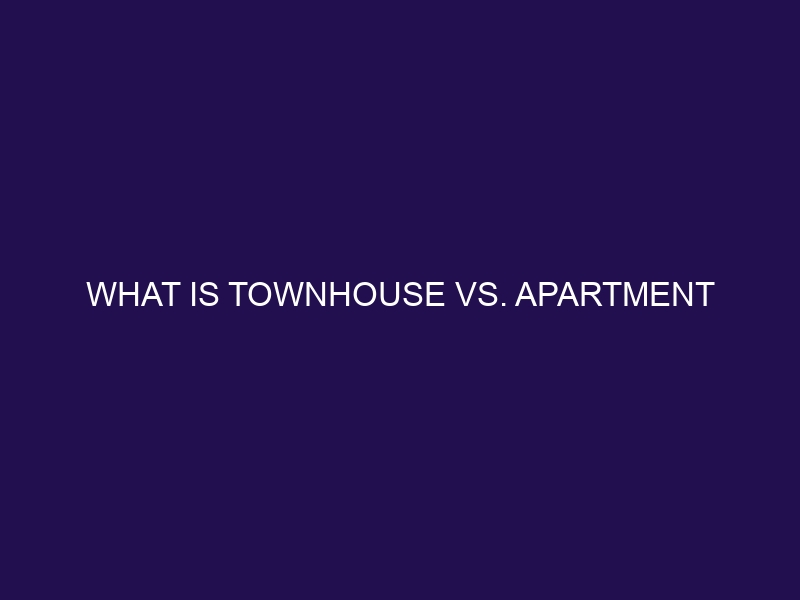What is Townhouse vs. Apartment
First Section:
When it comes to choosing a place to live, townhouses and apartments are two popular options that offer different living experiences. Understanding the differences between the two can help you make an informed decision based on your preferences and lifestyle.
A townhouse is a type of residential property that typically shares common walls with neighboring units and is often arranged in a row. It is designed to provide the feel of a standalone home while offering the convenience of shared amenities and maintenance.
Townhouses are usually multi-story properties, providing ample space for families or individuals who desire more room compared to an apartment. They are typically owned rather than rented and can be part of a homeowners association (HOA) that manages common areas and amenities.
Townhouses typically have separate entrances, multiple floors, and may include various amenities such as a backyard, garage, or basement. These properties often have a more traditional and spacious layout with distinct living, dining, and kitchen areas.
Living in a townhouse offers several advantages such as more privacy compared to apartments, access to outdoor space like a backyard, and potential for homeownership and equity. Townhouses also provide a sense of community within the neighborhood and are often located in desirable areas.
Townhouses may come with certain disadvantages including higher maintenance responsibilities, additional expenses for HOA fees, and restrictions on customization or renovations due to HOA regulations. Townhouses may have limited parking options depending on the development.
An apartment, also known as a flat, is a self-contained housing unit within a larger building or complex. Apartments are typically rented rather than owned and offer various amenities and services for residents.
Apartments are individual units within a larger building or complex that are usually owned and managed by a landlord or property management company. They can range in size and layout, accommodating individuals, couples, or families.
Apartments come in different styles and sizes, ranging from studio apartments with combined living and sleeping spaces to multi-bedroom units with separate rooms. They often feature shared amenities such as gyms, swimming pools, and common areas.
Living in an apartment offers advantages such as lower maintenance responsibilities, flexibility in terms of lease duration, and access to shared amenities. Apartments are often located in urban areas close to amenities like shopping centers, restaurants, and public transportation.
Some disadvantages of living in an apartment include limited privacy due to shared walls and close proximity to neighbors. Depending on the location and management, apartment living may also come with noise concerns and less control over customization compared to townhouses.
Understanding the differences between townhouses and apartments can help you assess which option aligns better with your needs and lifestyle.
Townhouses are typically owned and offer the potential for homeownership, while apartments are typically rented from a landlord or property management company.
Townhouses are generally larger and offer multiple floors, whereas apartments come in various sizes and layouts ranging from studio apartments to multi-bedroom units.
Townhouses generally offer more privacy with their separate entrances and fewer shared walls compared to apartments where noise levels may be more noticeable due to close proximity to neighbors.
Townhouse owners are responsible for the maintenance of their individual units and may have additional responsibilities if part of an HOA. In apartments, maintenance and repairs are typically the responsibility of the landlord or management company.
Deciding between a townhouse and an apartment ultimately depends on your preferences, lifestyle, and financial considerations. Consider factors such as space requirements, desired level of privacy, homeownership aspirations, and location preferences to determine which option aligns best with your needs.
What is a Townhouse?
Townhouses, those unique abodes that blend the best of both worlds – the space and privacy of a house, and the convenience and amenities of an apartment. In this section, we’ll unravel the essence of townhouses, exploring their defining characteristics, layout, and features. Get ready to discover the advantages and drawbacks that come with living in these distinctive dwellings, offering a fresh perspective on modern urban living.
1. Definition and Characteristics of Townhouses
A townhouse is a type of residential property that is typically characterized by multiple floors, shared walls, and a vertical layout. They are often designed in a row or a cluster, forming a cohesive community.
| Definition: | A townhouse is a single-family home attached to one or more neighboring units. |
| Characteristics: | Townhouses often have two or three stories, a private entrance, and may include amenities such as a yard or a garage. |
True story: Sarah was searching for a new home and fell in love with a charming townhouse. She loved the sense of community and the architectural style. The layout and spaciousness of the townhouse were perfect for her family’s needs. She appreciated having her own yard and the convenience of shared maintenance responsibilities with her neighbors. In the end, Sarah found that the definition and characteristics of townhouses aligned with her ideal home.
2. Features and Layout of a Typical Townhouse
- A typical townhouse features a multi-level design with shared walls, creating a sense of community and shared amenities within the complex. The layout often includes spacious living areas, multiple bedrooms, and bathrooms.
- Open floor plans: Townhouses often have an open layout on the first floor, creating a seamless flow between the living room, dining area, and kitchen.
- Private bedrooms: Most townhouses have multiple bedrooms on the upper levels, providing privacy and space for residents.
- Outdoor space: Many townhouses include a private patio or small backyard, allowing residents to enjoy outdoor living.
- Attached garage: Townhouses typically have an attached garage, providing convenient parking and additional storage space.
These features and layout elements contribute to the appeal and functionality of a typical townhouse, offering a desirable living option for individuals or families looking for a combination of shared community spaces and private living areas.
3. Advantages of Living in a Townhouse
Living in a townhouse offers several advantages that make it an attractive option for many individuals and families. Here are some of the key benefits:
- 1. Spaciousness: Townhouses typically offer more space compared to apartments, with multiple floors and rooms for a comfortable and spacious living experience.
- 2. Privacy: With only a few adjacent neighbors, townhouses offer more privacy compared to apartments, allowing residents to enjoy a quieter and more secluded living environment.
- 3. Outdoor Areas: Many townhouses come with private outdoor areas such as patios, balconies, or gardens, providing residents with their own outdoor space for relaxation or recreation.
- 4. Community Amenities: Townhouse communities often provide amenities like swimming pools, gyms, or parks, giving residents access to shared facilities and recreational opportunities.
- 5. Homeownership: Townhouses are often available for purchase, giving residents the opportunity to build equity, personalize their living space, and enjoy the benefits of homeownership.
Advantages of Living in a Townhouse include spaciousness, privacy, outdoor areas, community amenities, and homeownership. Townhouses typically offer more space compared to apartments, with multiple floors and rooms for a comfortable and spacious living experience. With only a few adjacent neighbors, townhouses offer more privacy compared to apartments, allowing residents to enjoy a quieter and more secluded living environment. Many townhouses come with private outdoor areas such as patios, balconies, or gardens, providing residents with their own outdoor space for relaxation or recreation. Additionally, townhouse communities often provide amenities like swimming pools, gyms, or parks, giving residents access to shared facilities and recreational opportunities. Furthermore, townhouses are often available for purchase, giving residents the opportunity to build equity, personalize their living space, and enjoy the benefits of homeownership.
4. Disadvantages of Living in a Townhouse
- Disadvantages of Living in a Townhouse:
- Limited Outdoor Space: Townhouses typically have smaller yards or no yards at all, which may be a disadvantage if you enjoy spending time outdoors.
- Shared Walls: Townhouses are attached to one or more neighboring units, which can result in more noise and less privacy compared to detached homes.
- HOA Fees: Townhouse communities often have homeowners’ association (HOA) fees, which can add to your monthly expenses.
- Stairs: Many townhouses have multiple levels, which means you may have to deal with stairs on a daily basis.
What is an Apartment?
Discover the fascinating world of apartments and uncover what sets them apart. From their defining characteristics to unique features and layouts, we’ll delve into the captivating realm of apartment living. Explore the advantages and disadvantages that come with residing in an apartment, providing insights into an increasingly popular housing choice. So, buckle up and get ready to unravel the secrets behind the allure of apartments.
1. Definition and Characteristics of Apartments
Apartments are housing units within a larger building complex that are rented out to individuals or families. Apartments, also known as rental units, are characterized by their shared common areas such as hallways, lobbies, and parking spaces. They come in a range of sizes, from studios to multiple-bedroom units, catering to diverse living needs. Additionally, apartments offer a variety of amenities like gyms, pools, and laundry facilities, providing convenience and enhancing the residents’ quality of life. One notable advantage of living in an apartment is that the property management takes care of maintenance and repairs, ensuring a hassle-free living experience. However, it is important to mention that apartments may have some drawbacks such as limited privacy and a lack of control over rent increases. Nonetheless, if you value a hassle-free lifestyle with easy access to additional facilities, living in an apartment can be the ideal choice for you.
2. Features and Layout of a Typical Apartment
The features and layout of a typical apartment can vary depending on the building and location. When considering a potential apartment, it is important to take into account several common aspects:
By evaluating these features, individuals can assess whether an apartment meets their specific needs and preferences for living arrangements.
3. Advantages of Living in an Apartment
Living in an apartment offers several advantages that make it a popular housing option. Here are the advantages of living in an apartment:
- Convenience: Apartments are often located in central areas, providing easy access to amenities, transportation, and entertainment.
- Lower Maintenance: Property maintenance and repairs are typically handled by the landlord or management company, freeing residents from the responsibilities of homeownership.
- Affordability: Renting an apartment is often more affordable than buying a townhouse, with lower upfront costs and predictable monthly expenses.
- Community Amenities: Many apartments offer shared facilities such as fitness centers, swimming pools, and communal spaces for socializing.
- Flexibility: Renting an apartment offers flexibility in terms of lease duration, allowing for easier relocation if needed.
Pro Tip: When renting an apartment, be sure to thoroughly review the lease agreement, understand the terms and conditions, and take note of any additional fees or rules specific to the apartment complex.
4. Disadvantages of Living in an Apartment
Disadvantages of Living in an Apartment
Living in an apartment comes with its own set of disadvantages that individuals should consider before making a decision.
- Lack of space: Apartments generally have limited living space, which can be a downside for individuals with large families or those who require extra room for hobbies or storage.
- Noisy neighbors: Apartments are often located in multi-unit buildings, resulting in potential noise disturbances from neighbors living in close proximity.
- Shared amenities: While apartment complexes may offer amenities such as pools or fitness centers, these spaces are shared with other residents and can become crowded or unavailable during peak times.
- Limited privacy: With close proximity to neighbors, maintaining privacy can be challenging, particularly when walls are thin or windows face other units or public spaces.
Differences Between Townhouses and Apartments
Discover the fascinating contrasts that exist between townhouses and apartments. From ownership and rental structures to size and layout, privacy and noise levels, and maintenance and homeownership responsibilities, each aspect showcases distinctive qualities. Get ready to uncover the various factors that set these two housing options apart, offering insights that will help you make an informed choice when deciding between a townhouse and an apartment. Let’s dive into the details and explore the features that make these living spaces unique.
1. Ownership and Rental Structure
When choosing between a townhouse and an apartment, ownership and rental structure are crucial factors to consider. Let’s compare these aspects using the following table:
| Ownership Structure | Rental Structure |
| Townhouse: | Apartment: |
| Ownership of the unit and the land it sits on. | Renting the unit from a landlord or property management company. |
| Responsibility for maintenance and repairs. | Landlord is typically responsible for maintenance and repairs. |
| Ability to customize and renovate the unit. | Restrictions on customization and renovations. |
| Opportunity for equity growth and potential property value appreciation. | No opportunity for equity growth or property value appreciation. |
2. Size and Layout
Size and layout are crucial factors to take into account when making a decision between a townhouse and an apartment. Consider your lifestyle and needs, as they play a significant role in choosing the right option.
In terms of size, townhouses generally offer more living space compared to apartments, which are usually smaller. When it comes to layout, townhouses often feature a private yard or patio, providing ample outdoor space, while apartments typically have limited outdoor areas, often limited to a balcony.
Additionally, townhouses tend to offer more storage options, such as basements or attics, whereas apartments may have limited storage facilities.
Ultimately, the decision should be based on your preferences and requirements. If you prioritize more space, privacy, and outdoor areas, a townhouse would be a suitable choice. On the other hand, if you prefer a compact and low-maintenance living space, an apartment could be a better fit. Assessing the size and layout of both options will help you make an informed decision.
3. Privacy and Noise Levels
When comparing townhouses and apartments, privacy and noise levels are crucial factors to take into account when making a decision. Here are some key points to consider:
- Privacy: Townhouses generally offer a higher level of privacy as they are standalone units with no neighbors above or below. In contrast, apartments may have shared walls and common spaces, which can lead to a decrease in privacy.
- Noise Levels: Apartments are more susceptible to noise from neighbors, especially if the walls are not soundproofed, due to the shared walls. On the other hand, townhouses, being separate units, tend to provide a quieter living environment.
- Outdoor Space: Townhouses often come with private yards or balconies, which offer an additional level of privacy when compared to apartments with shared outdoor spaces.
- Shared Amenities: Apartments usually offer shared amenities such as gyms or pools, which can contribute to increased noise levels due to more people utilizing them. Townhouses typically have limited shared amenities, resulting in a more tranquil environment.
4. Maintenance and Homeownership Responsibilities
When choosing between a townhouse and an apartment, it is important to consider maintenance and homeownership responsibilities. Here is a list of things to consider in terms of maintenance and responsibilities:
- Townhouse: As a townhouse owner, you will have more responsibility for maintenance and repairs, including exterior maintenance and landscaping.
- Apartment: In an apartment, maintenance and repairs are typically taken care of by the landlord or property management.
- Townhouse: You have the freedom to make any changes or improvements to your townhouse, but you also bear the costs involved.
- Apartment: In an apartment, you have limited control over making changes to the space, but you also don’t have to worry about the expenses.
- Townhouse: Homeowners’ association fees may be required to cover maintenance costs for shared amenities or services.
- Apartment: Rent may include the cost of some communal amenities or services, but you won’t have to pay separate fees.
Consider your preferences and lifestyle when deciding which is the best fit for you in terms of maintenance and homeownership responsibilities.
Which is Right for You: Townhouse or Apartment?
When deciding between a townhouse and an apartment, it’s important to consider various factors such as lifestyle, budget, and preferences. So, which is right for you: a townhouse or an apartment? Here are some things to think about:
- Space and Privacy: If you value having more space and privacy, a townhouse might be the better option. With multiple floors and private entrances, you’ll have plenty of room to spread out. On the other hand, apartments are more compact and often have shared hallways.
- Outdoor Space: Townhouses usually come with a private yard or balcony, allowing you to enjoy some outdoor space. In contrast, apartments may have communal outdoor areas or none at all.
- Amenities: Apartments often come with amenities like gyms and pools, providing extra convenience and luxury. Townhouses, however, may not offer such facilities.
- Maintenance: Keep in mind that in a townhouse, you’ll be responsible for your own maintenance. This means taking care of any repairs or upkeep that may arise. In an apartment, there is usually a property management team that handles maintenance tasks.
- Cost: If upfront costs and monthly rents are a significant factor for you, apartments generally have the advantage. They tend to be more affordable compared to townhouses.
Frequently Asked Questions
What is the difference between a townhouse and an apartment?
Townhouses and apartments are both types of residential properties, but they have some key differences. Apartments are usually single-story units within a building, while townhouses are multi-floor homes that share side walls with neighboring properties. Apartments are generally smaller in size with one or two bedrooms, while townhouses are larger and often have two or more bedrooms. Townhouses also usually have their own private outdoor space, like a garden or courtyard, whereas most apartments do not.
Who are ideal tenants for townhouses and apartments?
Ideal tenants for townhouses are often families or individuals looking for a larger home with luxurious facilities and no maintenance responsibilities. Townhouses can provide more living space and amenities like pools, gardens, and fitness centers. On the other hand, apartments are suitable for individuals or couples who prioritize affordability, flexibility, and minimal home maintenance. Apartments may not be ideal for families with young children due to space limitations.
What are the advantages of living in a condo?
Living in a condo allows you to invest in property while still enjoying the apartment lifestyle. You have the opportunity to own a modern condo and benefit from amenities and services provided by the condo association, such as maintenance of the exterior and shared amenities like a pool or fitness center. However, it is important to note that condo living requires following HOA rules and regulations and paying HOA fees.
How do townhouses, condos, and apartments compare in terms of prices?
Prices for townhouses, condos, and apartments can vary depending on factors such as location, size, amenities, and market conditions. Generally, townhouses tend to be more expensive than apartments due to their larger size and added features. Condos can also vary in price, but they may offer a balance between affordability and luxury. It is recommended to compare prices in the real estate market and work with a rental company or real estate agent to find the best option that fits your budget and lifestyle goals.
What are the long-term commitments associated with townhouses and apartments?
Both townhouses and apartments can be rented or bought, offering different long-term commitments. Renting an apartment or townhouse provides flexibility as you can easily relocate or make changes to your living situation. However, buying a townhouse or condo typically involves a longer-term commitment, as you become a homeowner and may need to consider factors like mortgage payments, maintenance, and the real estate market if you decide to sell in the future.
Can I make modifications to the interior of a townhouse or apartment?
The ability to make modifications or renovations can vary depending on the specific rental agreement or condo association rules and regulations. In general, apartments may have more limitations on modifications, such as drilling holes or making significant changes to the structure. Townhouses and condos may offer more flexibility, but it is important to review the rules and regulations set by the landlord or condo association before making any modifications.




